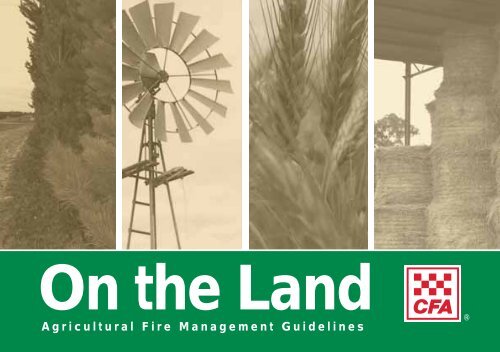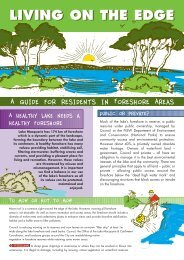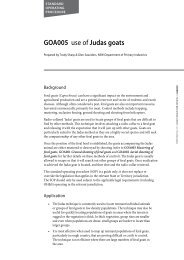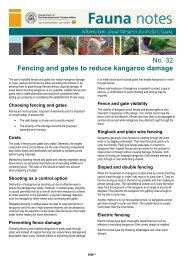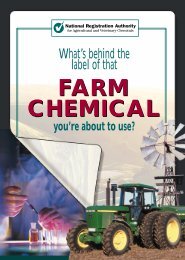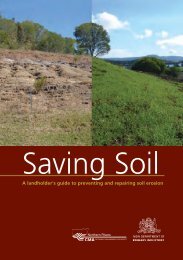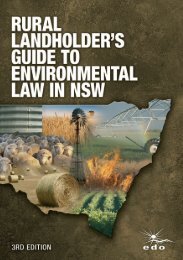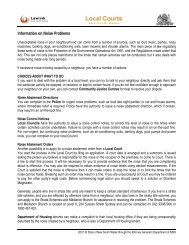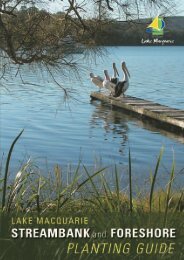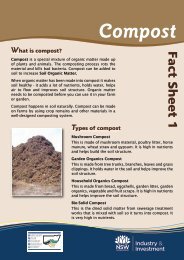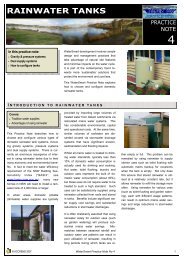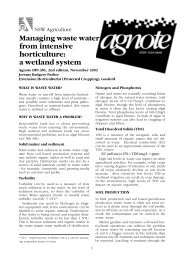Agricultural Fire Management Guidelines - Guide to Rural ...
Agricultural Fire Management Guidelines - Guide to Rural ...
Agricultural Fire Management Guidelines - Guide to Rural ...
Create successful ePaper yourself
Turn your PDF publications into a flip-book with our unique Google optimized e-Paper software.
On the Land®<strong>Agricultural</strong> <strong>Fire</strong> <strong>Management</strong> <strong><strong>Guide</strong>lines</strong>
ForewordNeil G. Bibby AFSMChief Executive Offi cer<strong>Fire</strong> management on agricultural land is important <strong>to</strong> protectthe safety and well-being of people and communities and <strong>to</strong>protect agricultural industries that are vital <strong>to</strong> Vic<strong>to</strong>ria.‘On the Land’ provides practical fi re management advice forpeople living and working on cropping, grazing, plantationtimber and rural lifestyle properties, particularly those whoare undertaking property planning or are new <strong>to</strong> farming.CFA appreciates the time and effort that a range ofindividuals and organisations have given <strong>to</strong> this project <strong>to</strong>help ensure that these guidelines are effective.CFA also appreciates the support of the State Government,as a result of the Vic<strong>to</strong>rian Bushfi re Inquiry, in developingthese guidelines.This document will be a useful reference for anyone involvedin planning or promoting fi re management on agriculturalland in Vic<strong>to</strong>ria.iiOn the Land: <strong>Agricultural</strong> <strong>Fire</strong> <strong>Management</strong> <strong><strong>Guide</strong>lines</strong>
Using This Documenthave legislated responsibilities regarding fi re managementand fi re extinguishment. Most of these responsibilitiesarise from the Country <strong>Fire</strong> Authority Act 1958, ForestsAct 1958, Summary Offences Act 1966 and Crimes Act1958. Landowners and managers may have additionalresponsibilities under other State or Federal legislation orlocal government requirements.This document integrates the legal responsibilities arisingfrom relevant fi re management legislation with advice <strong>to</strong>help landowners and managers form an overall picture ofwhat is needed <strong>to</strong> achieve fi re safety on rural properties.It is designed <strong>to</strong> be used for a number of purposes, suchas planning fi re management, as a <strong>to</strong>ol in informationor training courses and improving general communityknowledge about fi re management.Section 1 provides a general framework for fi re managemen<strong>to</strong>n private land. This has been used as the structure formore detailed advice in Section 3. Section 2 sets out somekey concepts that help <strong>to</strong> explain fi re management and fi remanagement planning.In this document:• ‘have a responsibility’, ‘in accordance with legislation’,‘are required <strong>to</strong>’ or ‘must’ means the information beingprovided is a legislated responsibility;• ‘advised <strong>to</strong>’ and ‘encouraged <strong>to</strong>’ means the advice beingprovided is good practice but not a legal requirement;• ‘wildfi re’ means both bushfi res and grassfi res;• ‘taking reasonable steps’ includes consideration of fi resafety, legal requirements, environmental issues, safetyresponsibilities and the long-term sustainability of theproperty; and• ‘ ’ indicates other documents that may provide moreinformation.This document provides general advice that may not berelevant in all circumstances. Landowners and managersare always encouraged <strong>to</strong> seek additional expert adviceabout fi re management on their property where required.On the Land: <strong>Agricultural</strong> <strong>Fire</strong> <strong>Management</strong> <strong><strong>Guide</strong>lines</strong>1
Section 2Understanding <strong>Fire</strong> <strong>Management</strong> (Background)Section 2 BackgroundFigure 1: Stubble burning<strong>Fire</strong> management involves fi re protection and using fi re for land management purposes such as stubble burning, weedcontrol or the management of native vegetation. <strong>Fire</strong> behaviour is how fi re spreads and burns given differences infuel, weather and <strong>to</strong>pography (shape of the land). This section provides general information that may be useful whenconsidering and planning fi re management.4 On the Land: <strong>Agricultural</strong> <strong>Fire</strong> <strong>Management</strong> <strong><strong>Guide</strong>lines</strong>
Section 2 BackgroundFuel<strong>Fire</strong> behaviour is infl uenced by three main fac<strong>to</strong>rs. These arefuel, weather and <strong>to</strong>pography. Consideration of these fac<strong>to</strong>rsis important when considering fi re management.Wildfi re can occur in any type of vegetation, such asgrasslands, trees, crops or shrubs. How hot a fi re burns andhow quickly it spreads depend on the size, quantity, type,arrangement and moisture content of the fuel being burnt.Fuel loadThe fuel load is the quantity of fuel per unit area. It iscommonly expressed as <strong>to</strong>nnes per hectare. Reducing fuelloads can help <strong>to</strong> protect assets from fi re and make fi reseasier <strong>to</strong> suppress.Fuel sizeFine fuels (less than 6 mm in diameter), such as leaves,twigs, grass and bark, dry out rapidly and burn quickly.Because fi ne fuels burn easily, they contribute most <strong>to</strong> theheat of a fi re front. Consequently, minimise the quantities offi ne fuels near key assets <strong>to</strong> minimise the risk of radiant heatand direct fl ame contact.Heavier fuels like branches and logs (greater than 25 mm indiameter) can also provide fuel for wildfi res. However, theyare slower <strong>to</strong> ignite than fi ne fuels and give off heat moreslowly.While heavy fuels do not contribute <strong>to</strong> the heat of the initialfi re front, they do need <strong>to</strong> be put out after the fi re front haspassed <strong>to</strong> prevent them being a continuing source of fi re.Drought conditionsWhen planning fi re management, consider the impact ofdrought and dry conditions. While grass paddocks tend<strong>to</strong> be heavily grazed in these situations, fi re managementstill needs <strong>to</strong> be undertaken as fi re can still travel acrosspaddocks with very short grass.During very dry conditions trees often shed leaves and theleaf litter dries out, increasing the amount of fuel available<strong>to</strong> burn in timbered areas, including plantations. Dry soilconditions associated with drought also increase the chanceof tree roots igniting. These fi res are diffi cult <strong>to</strong> suppress.Figure 3: Fine fuels less than 6 mm in diametercontribute most <strong>to</strong> the heat of a fire front6 On the Land: <strong>Agricultural</strong> <strong>Fire</strong> <strong>Management</strong> <strong><strong>Guide</strong>lines</strong>
Avoid these hill sites if possiblePreferred site on flat groundPreferred site on flat groundSection 2 BackgroundFigure 7: Locating a building in hilly countryOn the Land: <strong>Agricultural</strong> <strong>Fire</strong> <strong>Management</strong> <strong><strong>Guide</strong>lines</strong>9
Section 2 Background2. <strong>Fire</strong> management planningprocess<strong>Fire</strong> management planningEffective fi re management is a continual process thatinvolves:• planning for fi re safety;• implementing these plans;• checking that what was planned has been done and iseffective; and• reviewing and changing these plans when necessary.This type of continual process (see Figure 8 and Propertyfi re management plans, page31) occurs both at a propertyscale and at a larger public scale.Both scales are important <strong>to</strong>secure fi re safety across the rurallandscape.PlanDoGovernment authoritiesundertake fi re managementplanning as part of theirresponsibility for public safetyReviewCheckFigure 8: The continuousimprovement cycleand <strong>to</strong> support communities and industries. This includesdeveloping and implementing plans and documents such asmunicipal and regional fi re prevention plans and the Code ofPractice for <strong>Fire</strong> <strong>Management</strong> on Public Land (DSE 2006).At a property level, fi re management may range fromdeveloping and undertaking simple unwritten plans <strong>to</strong>more complex documented plans, depending on the riskspresent.<strong>Rural</strong> landowners and managers are encouraged <strong>to</strong> have awritten plan so that it is easier for them <strong>to</strong> consider fi re riskissues on their property and <strong>to</strong> communicate these issues <strong>to</strong>others.Risk managementThe concept of risk management underpins all decisionsin fi re management. It involves identifying fi re risks andbalancing the likelihood of a fi re against the consequencesshould one occur. For example, while an event like a fi remay be unlikely <strong>to</strong> happen, its consequences can be majoror even catastrophic. Consequently, plans are needed <strong>to</strong>minimise risk.When planning fi re management, it is important <strong>to</strong> thinkabout economic, environmental and social risks (risks <strong>to</strong>people). The impact of both fi re prevention activities and fi reitself can affect safety, the environment and the long-termsustainability of a property.10 On the Land: <strong>Agricultural</strong> <strong>Fire</strong> <strong>Management</strong> <strong><strong>Guide</strong>lines</strong>
Property fire management planning processStep 1: PlanIdentify and assess risks• Identify what the plan is trying <strong>to</strong> achieve.• Identify key assets and key fi re safety risks, including thosefrom adjacent properties and features.• Consider other risks such as economic, environmental andlegal risks.• Assess whether the risks identifi ed are relevant and/orsignifi cant <strong>to</strong> the property by considering the likelihood andconsequences of these risks happening.Plan <strong>to</strong> minimise risk• Select treatments that minimise the identifi ed risks.• Include consideration of safety, environmental and economicissues and the long-term sustainability of the property and/orenterprises, with safety as a priority.• Consider impacts on adjacent properties and features.• Consider it may not always be possible <strong>to</strong> protect all assetsfrom fi re or have fi re suppression services available.• Consult and work with adjacent public and privatelandowners, managers and land users <strong>to</strong> achieve fi re safetybenefi ts for all involved.• Locate fi re management works for the property within theproperty boundary, unless they are part of a cooperativeapproach, <strong>to</strong> ensure they are there when they are needed.Step 2: DoImplement the plan• Implement the property fi re management plan. A written planwill help <strong>to</strong> consider and communicate fi re risks.Step 3: CheckCheck the plan• Check that the fi re management works have beenundertaken, are still effective and have not had unintendedconsequences.Step 4: ReviewReview the plan• Review the plan regularly <strong>to</strong> ensure that it is still currentand effective. It should also be reviewed when beginningnew enterprises, undertaking a substantial change inexisting enterprises, or changing the property layout orinfrastructure, such as sheds or fences.Section 2 BackgroundPlan for recovery• Plan for recovery issues, such as insurance, weed problems,the long-term sustainability of the property and enterprises.On the Land: <strong>Agricultural</strong> <strong>Fire</strong> <strong>Management</strong> <strong><strong>Guide</strong>lines</strong>11
Section 2 Background3. <strong>Fire</strong> managementconceptsThe following concepts are important <strong>to</strong> consider whenplanning fi re management. The detail <strong>to</strong> support theseconcepts is contained in Section 3 of the document.Stay and defend or leave earlyMost houses can survive a fi re front if the building andsurrounding area are well prepared and actively defendedby suitably equipped people.The decision <strong>to</strong> stay and defend a property or leave early isa decision that shapes fi re management planning on mostrural properties.CFA recommends that where people decide <strong>to</strong> leave theirhomes they should do so before a fi re threatens and roadtravel becomes hazardous.Under Vic<strong>to</strong>rian law, residents have the right <strong>to</strong> decide forthemselves if they will stay with their property in a wildfi re ifthey have a pecuniary (fi nancial) interest in the property.However, once people have left their property, or if theyare away from home at the time of the fi re, they may beprevented from returning by the police. Living in the Bush (CFA 2004) Advice <strong>to</strong> the Community Before and During a Wildfi re (CFA 2006)Defendable spaceGiven the importance of key assets, such as homes andsheds, it is important <strong>to</strong> plan fi re management <strong>to</strong> helpminimise the risk that they will be affected by fi re. Animportant part of this is maintaining a defendable spacearound these important features.Figure 9: Cleaning up <strong>to</strong> create a defendable space12 On the Land: <strong>Agricultural</strong> <strong>Fire</strong> <strong>Management</strong> <strong><strong>Guide</strong>lines</strong>
Defendable space is an area surrounding a building that ismanaged <strong>to</strong> have signifi cantly reduced continuous vegetationor other fuels (see Vegetation management, page 35).Carefully managing the vegetation in this space limits theability of a moving fi re <strong>to</strong> ignite a building through fl amecontact or radiant heat. Defendable space also providesa relatively safe area from which <strong>to</strong> defend buildings fromember attack.A number of fac<strong>to</strong>rs, including design, materials andconstruction, siting, slope and vegetation type, infl uence theamount of defendable space required.Defendable space = inner zone + outer zone.The inner zone is an area with low fi re fuel for approximately10 m from buildings (see Figure 10). This reduces the risk ofember attack, radiant heat and direct fl ame contact.The outer zone is an area where fuels, such as vegetation,are carefully managed <strong>to</strong> a width of approximately 20 m <strong>to</strong>85 m past the inner zone, depending on such fac<strong>to</strong>rs as<strong>to</strong>pography and vegetation type.Sometimes it is not practical or responsible <strong>to</strong> defend aproperty or <strong>to</strong> have the distances suggested for defendablespace. Options are available <strong>to</strong> reduce the amount ofvegetation clearance required <strong>to</strong> obtain the required fi reprotection. Permits may also be required <strong>to</strong> remove nativevegetation in some circumstances. Building in a Wildfi re <strong>Management</strong> Overlay Applicant’s Kit(CFA 2007)20-85 m 10 mOuter ZoneInner ZoneOuter ZoneFigure 10: Defendable spaceSection 2 BackgroundOn the Land: <strong>Agricultural</strong> <strong>Fire</strong> <strong>Management</strong> <strong><strong>Guide</strong>lines</strong>13
Section 2 BackgroundProtecting the environmentTo help secure the long-term sustainability of a property, allfi re management planning needs <strong>to</strong> include consideration offi re safety, legal requirements, economic and environmentalissues.Protecting and improving the environment is an importantpart of sound fi re management planning (see Environmentalprotection, page 36). This is increasingly being recognisedin the management of rural land. For example, fi remanagement is often part of agricultural quality assurancesystems.Looking after the environment when undertaking fi remanagement includes:• identifying environmental assets (air, water, land andvegetation) and how they might be affected by fi re andfi re management activities;• avoiding environmental harm;• minimising harm where it cannot be avoided;• repairing environmental harm if it occurs; and• considering the use of fi re <strong>to</strong> improve the health of nativevegetation (ecological burning).Care needs <strong>to</strong> be taken <strong>to</strong> ensure that fi re managementdoes not cause unintended consequences such as a lossof vegetation, wildlife and scenic quality, weed invasion,erosion and water quality problems.As part of helping <strong>to</strong> protect the environment, permits areoften required <strong>to</strong> remove native vegetation. There are someexemptions for fi re safety. More information about thesepermits and exemptions is available at local councils.Sometimes fi re management can have both fi re safety andenvironmental benefi ts. The wick wiper machine picturedbelow is used <strong>to</strong> apply herbicide <strong>to</strong> taller introduced grasses(such as phalaris) leaving shorter native grasses (such askangaroo grass) that have a lower fuel load.Figure 11: A wick wiper used <strong>to</strong> wipe herbicide on tallgrasses for environmental and fire safety benefits14 On the Land: <strong>Agricultural</strong> <strong>Fire</strong> <strong>Management</strong> <strong><strong>Guide</strong>lines</strong>
<strong>Fire</strong> danger termsfi re safety issues.Total <strong>Fire</strong> BansTotal <strong>Fire</strong> Bans are declared on all land (both public andprivate land) in different districts in Vic<strong>to</strong>ria on days whenthe fi re danger is extremely high. The use of fi re during aTotal <strong>Fire</strong> Ban is very restricted and needs a special permit.Any normal permits already issued are suspended.<strong>Fire</strong> danger rating<strong>Fire</strong> danger refers <strong>to</strong> how diffi cult a fi re will be <strong>to</strong> controlgiven certain weather and fuel conditions. <strong>Fire</strong> danger isexpressed as a <strong>Fire</strong> Danger Index.Because they burn differently, separate fi re danger ratingsystems have been developed for forests and grasslands.<strong>Fire</strong>s in extreme fi re danger conditions are very diffi cult <strong>to</strong>control, even by well-equipped fi refi ghters.The likelihood of a fi re being successfully suppresseddepends on the <strong>to</strong>ols and people available and the weatherand fuel conditions. Even where the fi re danger rating ismoderate, a fi re will still be diffi cult <strong>to</strong> control without enoughpeople and adequate fi refi ghting equipment. Grassfi res: Fuel, Weather and <strong>Fire</strong> Behaviour(Cheney and Sullivan 1997)Bushfi res in Australia (Luke and McArthur 1978)<strong>Fire</strong> danger information is available from the AustralianBureau of Meteorology website for all Vic<strong>to</strong>rian districtsduring the <strong>Fire</strong> Danger Period. Follow the prompts <strong>to</strong> allVic<strong>to</strong>rian forecasts and then select bushfi re danger. Australian Bureau of Meteorology website (www.bom.gov.au)<strong>Fire</strong> Danger PeriodThe <strong>Fire</strong> Danger Period is declared each summer in eachmunicipality and stays in place until May 1, unless otherwisestated. During this time there are restrictions on fi re use inthe open and the operation of machinery and equipment.In <strong>Fire</strong> Protected Areas, including state forests, nationalparks, protected public lands and other reserves, fi rerestrictions remain in place all year.In some areas, land within 1.5 km of a <strong>Fire</strong> Protected Area(marginal mile) is also in the <strong>Fire</strong> Protected Area. <strong>Fire</strong>restrictions on this land are declared every year dependingon the fi re risk present. The Department of Sustainability andEnvironment and Parks Vic<strong>to</strong>ria offi ces can provide moreinformation on <strong>Fire</strong> Protected Areas.Figure 12: <strong>Fire</strong> danger meterSection 2 BackgroundOn the Land: <strong>Agricultural</strong> <strong>Fire</strong> <strong>Management</strong> <strong><strong>Guide</strong>lines</strong>15
Section 2 BackgroundFigure 13: Total <strong>Fire</strong> Ban Districts16 On the Land: <strong>Agricultural</strong> <strong>Fire</strong> <strong>Management</strong> <strong><strong>Guide</strong>lines</strong>
4. Fuel breaksmanagement on rural properties. Fuel breaks are anynatural or constructed breaks in fuel used <strong>to</strong> s<strong>to</strong>p or controlthe spread of wildfi re.There are different types of fuel breaks. Some s<strong>to</strong>p fi respreading horizontally at or near ground level; others s<strong>to</strong>pfi re spreading vertically in<strong>to</strong> trees. An understanding of thelikelihood of a fuel break being effective is an important par<strong>to</strong>f planning fi re management.The effectiveness of fuel breaksThe effectiveness of fuel breaks depends on the weatherconditions at the time, the width of the break and whetherembers are being produced.In grasslands, wider fuel breaks will s<strong>to</strong>p a greater rangeof fi res than narrow ones. Narrow breaks (under 3 m) areineffective except under the mildest of conditions.Most fuel breaks can have some effect at slowing theprogress of a fi re, in particular if the break:• is close <strong>to</strong> the source of fi re ignition so that the fi re hasnot built <strong>to</strong> its maximum potential;• is approached by the side (fl ank) of the fi re, because thefl ank has lower fi re intensity than the front (head) of thefi re;• effectively disrupts the vertical and/or horizontalcontinuity of the fuel, thereby reducing fi re intensity andmaking the fi re easier <strong>to</strong> suppress; or• provides access for suppression.Figure 14: Fuel breaks are less effective with trees nearbyFigure 15: Fuel breaks can be effective ifembers cannot cross the breakSection 2 BackgroundOn the Land: <strong>Agricultural</strong> <strong>Fire</strong> <strong>Management</strong> <strong><strong>Guide</strong>lines</strong>17
Section 2 BackgroundTypes of fuel breaksBare earth breaksBare earth breaks:• can be ploughed, graded, burnt and/or sprayed <strong>to</strong>ensure they are clear of fuel;• may s<strong>to</strong>p a fi re under low fi re danger conditions withoutanyone being present <strong>to</strong> fi ght the fi re;• will behave more like slashed breaks if there is somefuel left sitting on the surface. <strong>Fire</strong> will often move acrossslashed or mown breaks unless someone actively puts i<strong>to</strong>ut;• are less effective if nearby trees are producing embersthat can be blown across the break; and• may require a permit if they remove native vegetation. Grassfi res: Fuel, Weather and <strong>Fire</strong> Behaviour(Cheney and Sullivan 1997)Slashing and mowingSlashing and mowing are common ways <strong>to</strong> reduce fi rehazards. The rate of fi re spread in dry slashed grass isabout the same as in dry standing grass. However, the fl ameheight is approximately halved in the slashed grass, makinga fi re in slashed grass easier <strong>to</strong> control.Fuel reduction burningProperly conducted fuel reduction burning can be effectivein providing a fuel break. Fuel reduction burning should onlybe carried out with appropriate permits, with considerationof environmental issues and by people with experience inburning operations.Figure 16: Crop that has been cut and baled,providing hay and a fuel break18 On the Land: <strong>Agricultural</strong> <strong>Fire</strong> <strong>Management</strong> <strong><strong>Guide</strong>lines</strong>
Vertical breaks in timbered areasthe vertical continuity of fuel by pruning, slashing, barkmanagement and careful selection and placement ofshrubs. This minimises the risk of fi re moving <strong>to</strong> thecrowns of trees, thereby reducing the risk of embers beingproduced. Crown fi res are intense and diffi cult <strong>to</strong> suppress.Bark that is a fi re risk can be managed <strong>to</strong> reduce this risk.Long ribbon bark can sometimes be simply removed fromthe tree.Figure 17: In some plantations pruning lower branchescan have production and fire safety benefitsThe bark of some trees can be burnt <strong>to</strong> reduce the risk ofembers spotting and <strong>to</strong> reduce the risk of fi re travelling fromthe surface <strong>to</strong> the crowns of trees. Seek specialist advicebefore burning or removing bark.While fuel breaks inside timber plantations and farm forestryplantations can limit the spread of a low-intensity fi re andthe spread of the sides of higher-intensity fi res, they mightincrease the fi re activity near these gaps by increasing thespeed of the wind near these gaps.Despite these limitations, internal breaks in timberplantations and farm forestry plantations are still useful <strong>to</strong>help access fi re when it is small and <strong>to</strong> assist in fi re control.Herbicide useHerbicide can be used <strong>to</strong> create a fuel break. This could bea bare earth break or a break where dry fuel is still presentbut the fuel load has been reduced.Herbicide can also be used <strong>to</strong> reduce fuel loads <strong>to</strong> makefuel reduction burning safer and <strong>to</strong> keep fences, includingelectric fences, clear of weeds and grass.The most effective time <strong>to</strong> apply herbicide is in early springbefore grasses and weeds have grown. Take care with theuse of herbicides that weeds do not become herbicideresistant. Code of Practice for Farm Chemical Spray Application(DNRE 1999)Section 2 BackgroundOn the Land: <strong>Agricultural</strong> <strong>Fire</strong> <strong>Management</strong> <strong><strong>Guide</strong>lines</strong>19
Section 3<strong>Fire</strong> <strong>Management</strong> AdviceUsing this sectionThis section provides practical advice for planning andundertaking fi re management on rural properties, withadditional advice for fi re management on grazing, cropping,and timber plantations.This additional advice is indicated by the following symbols.Where there is no symbol used the advice being providedapplies <strong>to</strong> all properties.CroppingSection 3 AdviceGrazingTimberplantations20 On the Land: <strong>Agricultural</strong> <strong>Fire</strong> <strong>Management</strong> <strong><strong>Guide</strong>lines</strong>
Figure 18: Breaks in farm forestry for fire accessQuestions <strong>to</strong> consider .............................................22Planning fire management1. Personal safety.................................................302. Property fi re management plans......................313. Recovery planning ...........................................324. Property and building design and maintenance ...345. Vegetation management..................................356. Environmental protection.................................36Preventing fires starting7. Operating vehicles, machinery and equipment ... 378. Using fi re safely................................................409. <strong>Fire</strong> use regulations .........................................4110. <strong>Fire</strong> prevention issues ......................................44Limiting fires spreading11. Fuel breaks ......................................................4612. Reporting and extinguishing fi res ....................4813. <strong>Fire</strong> suppression ..............................................49Providing access for firefighting14. Building and property access..........................5015. Water supply access ........................................52Participating in community groups16. Community groups ..........................................54Section 3 AdviceOn the Land: <strong>Agricultural</strong> <strong>Fire</strong> <strong>Management</strong> <strong><strong>Guide</strong>lines</strong>21
Questions <strong>to</strong> considerThis list can be used as a prompt <strong>to</strong> consider fi re safety issues and assist in the preparation of property fi re managementplans. More detail is provided in this section on the pages indicated in the following tables. Responses <strong>to</strong> these questionscould be ‘Yes’, ‘No’, ‘Unsure’, or that the question is ‘Not Relevant’ <strong>to</strong> the property being considered.All Achieving Objective 1 – Planning Response1. Personalsafetypage303030a. Have you planned for the fi re safety of people living on,working on, or visiting this property?b. Do you have the necessary communication equipmentavailable?c. Are you prepared when fi ghting fi res on your propertyor other properties?Section 3 Advice2. Property firemanagementplans31 a. Do you have a fi re management plan for your property?313131b. Does your property have special needs <strong>to</strong> be identifi edin a relevant CFA brigade plan?c. Do you plan for the long term by considering future fi rerisks, such as when trees have fully grown?d. Are you aware of the relevant codes of practice orpermits needed <strong>to</strong> establish a plantation?22 On the Land: <strong>Agricultural</strong> <strong>Fire</strong> <strong>Management</strong> <strong><strong>Guide</strong>lines</strong>
All Achieving Objective 1 – Planning Response3. Recoveryplanning4. Propertyand buildingdesign andmaintenance5. Vegetationmanagement6. Environmentalprotectionpage323434343232a. Have you considered how people and your propertycan recover after a fi re?b. Have you planned how your pasture should bemanaged after a fi re?c. Have you considered the care of s<strong>to</strong>ck if your propertyis affected by fi re?a. Is fi re safety a part of the layout and building design ofyour property?b. Is your property in a Wildfi re <strong>Management</strong> Overlay orBushfi re Prone Area?c. Do you have a maintenance program <strong>to</strong> protect yourproperty against fi re?35 a. Is vegetation kept away from key assets and buildings?35363636b. Is fi re safety considered when selecting plants for yourproperty?a. Is consideration of environmental risks and benefi ts par<strong>to</strong>f planning fi re management on your property?b. Are you aware of the need for a permit <strong>to</strong> lop, destroy orremove native vegetation?c. Would you like <strong>to</strong> know more about ecological burningand whether it is relevant <strong>to</strong> your property?Section 3 AdviceOn the Land: <strong>Agricultural</strong> <strong>Fire</strong> <strong>Management</strong> <strong><strong>Guide</strong>lines</strong>23
All Achieving Objective 2 – Prevent fires starting Response7. Operatingvehicles,machineryandequipmentpage373737a. Would you consider s<strong>to</strong>pping high-risk fi re activities attimes of extreme fi re danger?b. Do you s<strong>to</strong>p and check when operating machinery andequipment?c. Have you minimised the risk that your vehicles andmo<strong>to</strong>rbikes will start a fi re?37d. Are you aware of what is required <strong>to</strong> operate machineryduring the <strong>Fire</strong> Danger Period?38e. Are you aware of what is required <strong>to</strong> operate equipmentduring the <strong>Fire</strong> Danger Period?38f. Are you aware of the restrictions on operating someequipment during a Total <strong>Fire</strong> Ban?39g. Have you considered s<strong>to</strong>pping harvesting at times ofextreme fi re danger?39h. Do you protect hay from the exhaust systems whencarting and cutting hay?Section 3 Advice8. Using firesafely404039i. Is timber harvesting scaled back or s<strong>to</strong>pped when thefi re danger rises?a & b. Do you plan ahead and consider safety and smokeissues when using fi re?c. Does your local council have requirements for, orrestrictions on, using fi re on your property?24 On the Land: <strong>Agricultural</strong> <strong>Fire</strong> <strong>Management</strong> <strong><strong>Guide</strong>lines</strong>
All Achieving Objective 2 – Prevent fires starting Response9. <strong>Fire</strong> useregulationspage414142a. Do you know what Total <strong>Fire</strong> Ban District your propertyis in?b. Do you know what is required when using fi re duringthe <strong>Fire</strong> Danger Period?c. Is your property in a <strong>Fire</strong> Protected Area? Do you knowwhat is required when using fi re in these areas?42 d. Do you burn rubbish and use an incinera<strong>to</strong>r safely?10. <strong>Fire</strong>preventionissues43e. Do you know what is required <strong>to</strong> use fi re safely outsidethe <strong>Fire</strong> Danger Period?44 a. Do you know what fi re prevention notices are?44b & c. Are there private powerlines and electric fences onyour property? Are they maintained for fi re safety?44 d. Do you s<strong>to</strong>re fuel, chemicals and gas correctly?4545e. Do you minimise fi re risk in large compost and manureheaps?f. Do you have smoking and public access policies foryour plantation?45 g. Do you locate and s<strong>to</strong>re hay <strong>to</strong> minimise fi re risk?Section 3 AdviceOn the Land: <strong>Agricultural</strong> <strong>Fire</strong> <strong>Management</strong> <strong><strong>Guide</strong>lines</strong>25
All Achieving Objective 3 – Limit fires spreading Response11. Fuel breaks page464646464647a. Do you know what permits may be required whencreating fuel breaks?b. Do you have perimeter breaks? Where required, dothese incorporate an access track?c. Does your property require, and if necessary have,internal fuel breaks?d. Have you included existing features, such as waterbodies, as fuel breaks in your fi re management plan.e. Do you have fenced off areas that need fi remanagement?f. Do you have fuel management in planted timber areas<strong>to</strong> minimise the risk of fi re spreading?47 g. Have you incorporated fuel breaks in<strong>to</strong> your plantation?Section 3 Advice26 On the Land: <strong>Agricultural</strong> <strong>Fire</strong> <strong>Management</strong> <strong><strong>Guide</strong>lines</strong>
All Achieving Objective 3 – Limit fires spreading Response12. Reportingandextinguishingfires13. <strong>Fire</strong>suppressionpage4849494949a. Do you know your responsibilities <strong>to</strong> report andextinguish fi res?a. Do you have adequate equipment <strong>to</strong> s<strong>to</strong>p the spread offi re on your property?b. Do you have a plan for how <strong>to</strong> respond <strong>to</strong> a fi re on yourproperty?c. Are you required <strong>to</strong> form, or be part of, a Forest IndustryBrigade?d. Do you have a preparedness and response plan foryour plantation?Section 3 AdviceOn the Land: <strong>Agricultural</strong> <strong>Fire</strong> <strong>Management</strong> <strong><strong>Guide</strong>lines</strong>27
All Achieving Objective 4 – Access Response14. Building andpropertyaccesspage50a. Is there adequate tanker access <strong>to</strong> and around yourbuildings and property?50 b. Are your access tracks suitable for CFA tankers?51c. Are gates <strong>to</strong> be used for CFA tanker access at least 3 mwide?51 d. Do you have fi re access breaks in planted timber areas?Section 3 Advice15. Water supplyaccess5152525151e. Are your crossing points for tankers capable of bearinga load of at least 15 <strong>to</strong>nnes?f. Is there adequate access for fi refi ghting on yourplantation?g. Is there adequate access for fi refi ghting around yourraised bed crops?a. Is there an adequate and identifi ed fi refi ghting watersupply for your property?b. Is there an adequate and identifi ed fi refi ghting watersupply for your buildings?53 c. Do you have CFA compatible fi ttings on your tanks?28 On the Land: <strong>Agricultural</strong> <strong>Fire</strong> <strong>Management</strong> <strong><strong>Guide</strong>lines</strong>
Section 3 Advice2929292929292929292929292929292929292929292929292929292929292929292929292929292929292929292929292929292929292929292929292929292929292929292929292929292929292929292929292929292929292929292929OnOnOnOnOnOnOnOnOnOnOnOnOnOnOnOnOnOnOnOnOnOnOnO thehehehehehehehehehehehehehehehehehehehe Lanananananananananananananananananananananananana d:d:d:d:d:d:d:d:d:d:d:d:d:d:d:d:d:d:d:d:d:d:d:d:d:d:d:d:d:d:d:d:d Agrgrgrgrgrgrgrgrgrgrgrgrgrgrgrgrgrgrgrgrgrgrgrgrgrgrgrgrgrgrgrgrgrgrgrgrgrgrgrgrgrgrgrgrgrgrgrgrgrgrgrgrgrgrgrgrgrgrgrgrgrgrgrgrgrgrgrgrgrgrgrgrgrgrgrgrgrgrgrgrgrgrgrgrg icicicicicicicicicicicicicicicicicicicicicicicicicicicicicicicicicicicicicicicicicicicicicicicicicicicicicicicicicicicicicic lululululululululululululululululululululululululululululululululululululululululululululululululululululululululululululululululululululululululu ututututututututututututututututututututututututututututututututututututututututututututututututututututututututututututututututututututurarararararararararararararararararararararararararararararararararararararararararararararararararararararararararararararararararararararararararararararararararararararal FiFiFiFiFiFiFiFiFiFiFiFiFiFiFiFiFiFiFiFiFiFiFiFiFiFiFiFiFiFiFiFiFiFiFiFiFiFiFiFiFiFiFiFiFiFiFiFiFiFiFiFiFiFiFiFiFiFiFiFiFiFiFiFiFiFiFi<strong>Fire</strong>rerererererererererererererererererererererererererererererererererererererererererererererererererererererererererererererererererererererererererererererererererere Mananananananananananananananananananananananananananananananananananananananananananananananananananananananananananananananananananananananananananananananananananananananananananananananananananana agagagagagagagagagagagagagagagagagagagagagagagagagagagagagagagagagagagagagagagagagagagagagagagagagagagagagagagagagagagagagagagagagagagagagagagagagagagagagagagagagagagagagagagagagagagagagagagagagagagagagagagagagagagagagagagagagagagagagagagagagagagagagagagagagagagagememememememememememememememememememememememememememememememememememememememememememememememememememememememememememememememememememememememememememememememememememememememememememememememememememememememememememememememememememememememememeenenenenenenenenenenenenenenenenenenenenenenenenenenenenenenenenenenenenenenenenenenenenenenenenenenenenenenenenenenenenenenenenenenenenenenenenenenenenenenenenenenenenenenenenenenenenenenenenenenenenenenenenenenene t GuGuGuGuGuGuGuGuGuGuGuGuGuGuGuGuGuGuGuGuGuGuGuGuGuGuGuGuGuGuGuGuGuGuGuGuGuGuGuGuGuGuGuGuGuGuGuGuGuGuGuGuGuGuGuGuGuGuGuGuGuGuGuGuGuGuGuGuGuGuGuGuGuGuGuGuGuGuGuGuGuGuGuGuGuGuGuididididididididididididididididididididididididididididididididididididididididididididididididelelelelelelelelelelelelelelelelelelelelelelelelelelelelelelelelelelelelelelelelelelelele inininininininininininininininininininininininininininininininesesesesesesesesesesesesesesesesesesesesesesesesesesesesesesesesesesesesesesesesesFigure 19: Community groupOn the Land: <strong>Agricultural</strong> <strong>Fire</strong> <strong>Management</strong> <strong><strong>Guide</strong>lines</strong>All Achieving Objective 5 – Community groups Response16. Communitygroupspage54a. Have you considered joining your local CFA and/orbecoming involved in other fi re awareness groups?54b. Would you consider raising fi re safety issues with othergroups?
Section 3 Advice1. Personal safetyThe most important aspect of fi re management is the safetyof people.a. Bushfire survival planWhile all individuals have a responsibility for their ownsafety, landowners and managers have an additionalresponsibility for the safety of people living on, working onand visiting their property and are encouraged <strong>to</strong> develop abushfi re survival plan (see Stay and defend or leave early,page 12).During wildfi re, a signifi cant threat <strong>to</strong> personal safety isradiant heat. Radiant heat cannot penetrate through solidobjects, so the best way <strong>to</strong> avoid the dangers of radiant heatis <strong>to</strong> shelter inside a building as the fi re front passes. You arealso advised <strong>to</strong> wear appropriate protective clothing madeof natural fi bres.Radiant heat from fi re kills people who are caught out inthe open. Often the people most at risk are those whoundertake last-minute actions, such as moving lives<strong>to</strong>ck.When working in locations without easy access <strong>to</strong> buildingsor homes, people are encouraged <strong>to</strong> have a fi re blanket,suitable wire cutters, water and a simple plan about wherethey would shelter if they were caught in a wildfi re. Cars donot provide adequate shelter from radiant heat; however,sheltering in a car is better than being caught without anyshelter at all. Living in the Bush (CFA 2004) Radiant Heat (CFA 1998) The Complete Bushfi re Safety Book (Webster 2000) The Australian Bushfi re Safety <strong>Guide</strong> (Schauble 2004)b. Maintaining communicationFor safety reasons, it is important for those working on ruralproperties <strong>to</strong> stay in contact with others. Individuals areencouraged <strong>to</strong> carry communication equipment, such as aUHF radio or mobile phone, when undertaking any farmingactivities and <strong>to</strong> tune <strong>to</strong> ABC Radio or a relevant local radioon days of high fi re danger.c. Private firefightingPeople are advised <strong>to</strong> be well prepared when undertakingprivate fi refi ghting activities. <strong><strong>Guide</strong>lines</strong> for Operating Private Equipment at <strong>Fire</strong>s (CFA 2004)30 On the Land: <strong>Agricultural</strong> <strong>Fire</strong> <strong>Management</strong> <strong><strong>Guide</strong>lines</strong>
2. Property fi re managementplansimplement an effective property fi re management plan thatidentifi es and addresses fi re risks present on their property,including how <strong>to</strong> respond <strong>to</strong> and recover from a fi re.a. Typical plan contentsA property fi re management plan should include plansfor personal safety, fi re prevention, asset protection, fi resuppression and recovery from fi re (see <strong>Fire</strong> managementplanning process, pages 10 and 11). Living in the Bush (CFA 2004) Environmental Best <strong>Management</strong> Practice on Farms (DPI 2006) Roadside <strong>Fire</strong> <strong>Management</strong> <strong><strong>Guide</strong>lines</strong> (CFA reprinted 2005)b. Identifying special needsLandowners and managers with special requirements for fi resuppression on their property, such as organic farms, areencouraged <strong>to</strong> contact their regional CFA offi ce and ensurethat their requirements are entered in<strong>to</strong> CFA brigade plans. Class A Foam, Wetting Agent and Your Property (CFA 2003)c. Planning for the long term<strong>Fire</strong> management needs <strong>to</strong> be planned for the long term <strong>to</strong>be effective.Each stage of a pasture, crop or plantation will have differentfuel load and different fuel arrangement characteristics.Plan for the stage where the fuel hazard will be greatest. Forexample, plan ahead <strong>to</strong> minimise the fi re risk when trees orcrops have fully grown.d. Plantation establishmentIn accordance with legislation, commercial forestson private land must be established and harvested inaccordance with the Code of Forest Practices for TimberProduction (DSE 2006).When establishing new plantations, landowners andmanagers are encouraged <strong>to</strong> contact their local councilabout planning scheme requirements, such as permits,setbacks from dwellings and buildings, and plantationdevelopment notices.Section 3 AdviceOn the Land: <strong>Agricultural</strong> <strong>Fire</strong> <strong>Management</strong> <strong><strong>Guide</strong>lines</strong>31
3. Recovery planningPlanning for recovery is an important part of minimising theimpact of fi re. The period following a fi re can be diffi cult, butit can also provide an opportunity <strong>to</strong> implement change.• The Department of Human Services assists in meetingthe welfare needs of people.• The Department of Primary Industries provides technicalagricultural advice before and after a fi re.• The Department of Sustainability and Environmentprovides environmental advice.Section 3 Advicea. Recovery planningLandowners and managers are encouraged <strong>to</strong> plan forrecovery as part of an overall plan for fi re management ontheir property (see <strong>Fire</strong> management planning process,pages 10 and 11).Issues <strong>to</strong> consider in recovery plans include:• the welfare of people;• weed management, erosion control, environmentalissues;• s<strong>to</strong>ck management;• insurance needs (personal and business); and• possible changes <strong>to</strong> fencing, sheds and property layoutand enterprises.A number of organisations provide assistance before andafter a fi re has happened:• Local councils coordinate the recovery of the communityafter fi re. They are often the initial contact point forrecovery issues.b. Pasture managementLandowners and managers are encouraged <strong>to</strong> planahead <strong>to</strong> manage pasture after fi re. Pasture Recovery after <strong>Fire</strong> (Agriculture Note, DPI 1995)c. S<strong>to</strong>ck management planHave a low-fuel area for s<strong>to</strong>ck during a wildfi re situation.This could be a grazed or green paddock or a grazedlaneway. Consider having a central laneway <strong>to</strong> manages<strong>to</strong>ck and move them before fi re threatens. Considertrucking out important s<strong>to</strong>ck where practical.Plan a containment area where s<strong>to</strong>ck can be fed aftera fi re. This reduces the risk of weed spread across theproperty. Moni<strong>to</strong>r this area for weeds. Horses and Bushfi res (Agriculture Note, DPI 2007) Living in the Bush (CFA 2004)32 On the Land: <strong>Agricultural</strong> <strong>Fire</strong> <strong>Management</strong> <strong><strong>Guide</strong>lines</strong>
Section 3 AdviceFigure 20: Plan ahead <strong>to</strong> protect key assets such as s<strong>to</strong>ckOn the Land: <strong>Agricultural</strong> <strong>Fire</strong> <strong>Management</strong> <strong><strong>Guide</strong>lines</strong>33
Section 3 Advice4. Property and buildingdesign and maintenanceCareful property layout and building design can providelong-lasting fi re safety benefi ts.a. Property layout and building designConsider property layout <strong>to</strong> minimise the chance that fi re willimpact on key assets.A key step in maximising the chance that buildings, such ashouses and sheds, will survive a wildfi re is <strong>to</strong> minimise theimpact of embers. This may involve such ideas as creatinga defendable space around buildings (see Defendablespace, pages 12 and 13) and ensuring that there are nogaps between the shed cladding and the ground or slab <strong>to</strong>prevent embers entering sheds.Consider using windbreaks <strong>to</strong> slow wind approaching keyassets and <strong>to</strong> catch embers before they reach these assets.Use vegetation in the windbreaks that produces a minimumof embers. Landscape and Building Design for Bushfi re Areas (Ramsay andRudolph 2003) The Australian Bushfi re Safety <strong>Guide</strong> (Schauble 2004)The Complete Bushfi re Safety Book (Webster 2000)Living in the Bush (CFA 2004)b. Building in high fire risk areasBuildings in a Wildfi re <strong>Management</strong> Overlay or Bushfi reProne Area have special building requirements <strong>to</strong> protectthem from fi re. Contact local council for more information onthis issue. Building in a Wildfi re <strong>Management</strong> Overlay Applicant’s Kit(CFA 2007) AS 3959-1999, Construction of Buildings in Bushfi re-Prone Areas(Standards Australia 1999) Building in Bushfi re-Prone Areas: Information and Advice (Ramsayand Dawkins 1993) Property Bushfi re Preparation and Native Vegetation <strong>Management</strong>Case Study (CFA 2004)c. MaintenanceGood building and property design is only effective if it issupported by good maintenance. Maintain low fuel loadsaround buildings and assets by managing vegetation (seeVegetation management, page 35) and locating items suchas woodpiles or old tyres away from these assets. Living in the Bush (CFA 2004)34 On the Land: <strong>Agricultural</strong> <strong>Fire</strong> <strong>Management</strong> <strong><strong>Guide</strong>lines</strong>
5. Vegetation managementThe Complete Bushfi re Safety Book (Webster 2000)Living in the Bush (CFA 2004)on all properties. <strong>Management</strong> of vegetation on the propertycan have fi re safety and environmental benefi ts.a. Managing vegetationProtect assets by reducing fuel loads around house blocksand sheds. Protect fences from radiant heat and direct fl amecontact by keeping them free of vegetation and weeds.Landowners and managers are advised <strong>to</strong>:• keep dense stands of shrubs away from the inner zone,which is 10 m around buildings (see Defendable space,pages 12 and 13);• use low fi re fuel options, such as green lawns, pavingand pebble mulch near buildings;• consider having clumps of vegetation rather thancontinuous vegetation; and• design vegetation layout near buildings so that fi re is notfunnelled <strong>to</strong>wards key assets. Landscape and Building Design for Bushfi re Areas (Ramsay andRudolph 2003) The Australian Bushfi re Safety <strong>Guide</strong> (Schauble 2004)b. Selecting vegetationTo protect the long-term value of property, consider plantingvegetation that regenerates or reshoots after a fi re.It is diffi cult and complex <strong>to</strong> suggest specifi c plants for fi resafety because the way a plant burns depends on suchissues as how old it is, how well watered and managed it is,and what is growing nearby.It is suggested that plants that burn easily and produceembers be located away from buildings. This includesplants that:• create dry, dead debris;• have loose fl aky bark;• have a lot of fi ne leaves, particularly if they arecontinuous from the ground up; and• have very low moisture content.While some plants may burn more readily than others,under the right conditions all plants will burn. Consequently,do not rely solely on plants being fi re resistant for fi re safety.Section 3 AdviceOn the Land: <strong>Agricultural</strong> <strong>Fire</strong> <strong>Management</strong> <strong><strong>Guide</strong>lines</strong>35
Section 3 Advice6. Environmental protectionAs part of a fi re management plan, consider how <strong>to</strong> protectthe property from environmental damage and promoteenvironmental assets, such as native vegetation (seeProtecting the environment, page 14).a. Environmental planningLandowners and managers are encouraged <strong>to</strong>:• identify environmental assets that require protectionfrom wildfi re or from fi re management works, such asfuel-reduction burning. This may include such areas aswaterways, habitat for native fauna, and revegetationsites;• ensure that fi re management works do not result inlarge areas of bare ground that may cause erosion andencourage the growth of weeds;• remove weeds that have high fuel loads for fi re safetyand environmental benefi ts;• minimise soil disturbance around trees <strong>to</strong> protect thehealth of trees;• consider protecting trees with hollows that are habitat fornative fauna;• where necessary, rehabilitate areas as soon as possibleafter a fi re or after undertaking fi re management works;• seek approvals and permits where required; and• seek advice on how <strong>to</strong> improve environmental assets onyour property.b. Native vegetation removalNative vegetation is an important asset on most ruralproperties. Sometimes native vegetation needs <strong>to</strong> bemanaged or removed for fi re safety reasons.In accordance with legislation, a planning permit isrequired <strong>to</strong> remove, lop or destroy native vegetation unlessan exemption applies. Contact local councils for moreinformation on these exemptions. Native Vegetation Removal, Section 52.17, Vic<strong>to</strong>rian planningschemesc. Ecological burningWhen used in appropriate cycles, fi re is a powerful <strong>to</strong>ol thatcan be used <strong>to</strong> promote the health of native vegetation. Thisis called ecological burning. <strong>Fire</strong> and environment information on Department of Sustainabilityand Environment website (www.dse.vic.gov.au)36 On the Land: <strong>Agricultural</strong> <strong>Fire</strong> <strong>Management</strong> <strong><strong>Guide</strong>lines</strong>
7. Operating vehicles,machinery and equipment(including days of Total <strong>Fire</strong> Ban) unless they are fi ttedwith a system that takes all of the exhaust from the enginethrough the silencing system. CFA Act 1958, s50responsibility <strong>to</strong> ensure that they do not start a fi re.a. Extreme fire danger daysConsider fi re risk before harvesting, grinding and welding,slashing and mowing, or driving vehicles and mo<strong>to</strong>rbikesthrough dry grass or crop. Driving vehicles with catalyticconverters through dry grass and crops is particularlyhazardous.b. Checking for fire risksAnyone operating vehicles, machinery and equipment isencouraged <strong>to</strong> take regular breaks <strong>to</strong> check such items asstraw or grass build-up and hot bearings and <strong>to</strong> regularlylook behind for fi re. Opera<strong>to</strong>rs are encouraged <strong>to</strong> check thatmachinery and equipment will not start a fi re before leavingthem unattended.c. Vehicles and mo<strong>to</strong>rbikesIn accordance with legislation, vehicles and mo<strong>to</strong>rbikespropelled with an internal combustion engine must notcontact any type of vegetation during the <strong>Fire</strong> Danger Periodd. MachineryIn accordance with legislation, machinery incorporatinga heat engine operating during the <strong>Fire</strong> Danger Period(including days of Total <strong>Fire</strong> Ban) in contact with, or within9 m of, crop, grass, stubble, weeds, undergrowth or othervegetation must:• be free from faults and defects that could cause fi res;• be fi tted with a working and maintained appropriatespark arres<strong>to</strong>r (except if fi tted with a turbocharger or anaspirated exhaust air cleaner); and• carry a working water fi re extinguisher or knapsack of atleast 9 litres capacity. CFA Act 1958, s50 CFA Regulations 2004, r.109 Can I Can’t I (CFA 2006)In addition <strong>to</strong> water required under legislation, peopleare encouraged <strong>to</strong> carry a dry chemical fi re extinguisheron machinery that is suitable for Class A fi res (normalcombustible materials), Class B fi res (fuels and otherfl ammable liquids) and electrical fi res.Section 3 AdviceOn the Land: <strong>Agricultural</strong> <strong>Fire</strong> <strong>Management</strong> <strong><strong>Guide</strong>lines</strong>37
Section 3 Advicee. EquipmentIn accordance with legislation, equipment incorporatingnon-vehicle heat engines should only be used in the openif it is fi tted with a spark arrester, except if the equipment isbeing used <strong>to</strong> cut green vegetation.Non-vehicle heat engines operating in the open during the<strong>Fire</strong> Danger Period must also have:• an area around the heat engine clear of fl ammablematerial for a radius of at least 3 m; or• a person in attendance at all times the heat engine isoperating (unless operating with a special exemption);and they have a working water fi re extinguisher orknapsack of at least 9 litres capacity.While this equipment can be used on days of Total <strong>Fire</strong> Ban,consider postponing this work. CFA Regulations 2004 r.110 Can I Can’t I (CFA 2006)f. Cutting, welding and grinding equipmentIn accordance with legislation, cutting, welding, solderingand grinding type of equipment can be used during the <strong>Fire</strong>Danger Period provided that:• a fi re-resistant shield or guard is placed <strong>to</strong> s<strong>to</strong>p sparksand hot material;• an area of at least 1.5 m from the operation is clear offl ammable material or wet down enough <strong>to</strong> prevent thespread of fi re;• there is a water supply or an effective water knapsack ofat least 9 litres capacity available for immediate use; and• cut-offs and electrode stubs are placed directly in afi reproof container. CFA Act 1958, s38A(c)In accordance with legislation, cutting and weldingequipment that produces fi re and heat, such as welders, gascutting, soldering, grinding or charring equipment, cannotbe used on days of Total <strong>Fire</strong> Ban in the open air without aspecial permit obtained from CFA regional offi ces. CFA Act 1958, s4038 On the Land: <strong>Agricultural</strong> <strong>Fire</strong> <strong>Management</strong> <strong><strong>Guide</strong>lines</strong>
g. Grain harvestingHarvesting is a high fi re risk activity that requiresparticular care. As part of helping <strong>to</strong> protect thecommunity from fi re consider avoiding harvesting attimes of extreme fi re danger.Anyone harvesting is encouraged <strong>to</strong> have access<strong>to</strong> private fi refi ghting equipment during harvestingoperations in addition <strong>to</strong> that required under legislation.h. Hay cutting and cartingConsider the fi re risk conditions present when cuttinghay. Anyone carting hay is encouraged <strong>to</strong> have afi re-resistant cover on the load or have a spark shieldbehind the exhaust.Alternatively, have an exhaust system that is locatedunder the body of the vehicle <strong>to</strong> ensure that the exhaustemissions are away from the hay.i. Harvesting timberIn accordance with the Code of Forest Practices forTimber Production (DSE 2006), timber harvesting isrequired <strong>to</strong> be based on a Timber Harvesting Plan. Thisplan may include fi re protection restrictions.Consider scaling down harvesting operations when theForest <strong>Fire</strong> Danger Index increases above 30 in hillycountry and above 45 on fl at land.Section 3 AdviceFigure 21:CropharveststiningOn the Land: <strong>Agricultural</strong> <strong>Fire</strong> <strong>Management</strong> <strong><strong>Guide</strong>lines</strong>39
Section 3 Advice8. Using fi re safely<strong>Fire</strong> is a normal part of farming activities. The safe use of fi reis encouraged.a. Planning fire useBefore burning, anyone using fi re is encouraged <strong>to</strong>:• be clear about what the burning will achieve;• identify risks and how they will be managed;• ensure that weather conditions are and will remain safefor burning;• have fuel breaks <strong>to</strong> contain the fi re;• have suffi cient resources on hand <strong>to</strong> control the fi re;• obtain permits <strong>to</strong> burn (see <strong>Fire</strong> use regulations, pages41 <strong>to</strong> 43) and/or remove native vegetation wherenecessary;• notify Vic<strong>Fire</strong> (see Vic<strong>Fire</strong> burnoff notifi cations options,page 62) and neighbours if required, or if the burningmay affect them; and• seek advice on fi re safety, fl ora and fauna, and weedmanagement issues.After using fi re, people are encouraged <strong>to</strong>:• check <strong>to</strong> ensure that the fi re is completely out;• moni<strong>to</strong>r the site for fi re over the next few days; and• where necessary, rehabilitate the burn site or controllines as soon as practical. Synopsis of the Knowledge Used in Prescribed Burning in Vic<strong>to</strong>ria(DNRE 1999)It is an offence <strong>to</strong> intentionally or recklessly cause a fi re andrecklessly allow a fi re <strong>to</strong> spread <strong>to</strong> vegetation on anotherperson’s property. Crimes Act 1958, s201Ab. Smoke managementAnyone using fi re is required <strong>to</strong> consult with the relevantroad authority (council or VicRoads) if the proposed burningmay impact on road safety.Anyone using fi re is encouraged <strong>to</strong> minimise the impact ofsmoke on air quality by burning when the fuel is dry andwhen the wind will not blow smoke <strong>to</strong>wards neighbours,<strong>to</strong>wns or settlements.c. Local council permitsLocal government often has local laws regarding lightingfi res and burning rubbish in their municipality, especiallynear <strong>to</strong>wnships or in built-up areas.Landowners and managers are encouraged <strong>to</strong> check withtheir local council about local laws regarding the use of fi rein their area.40 On the Land: <strong>Agricultural</strong> <strong>Fire</strong> <strong>Management</strong> <strong><strong>Guide</strong>lines</strong>
9. <strong>Fire</strong> use regulationscommunity safe from unplanned fi re.Can I Can’t I (CFA 2006)a. Total <strong>Fire</strong> Ban daysIn accordance with legislation, where a Total <strong>Fire</strong> Banapplies, it is an offence <strong>to</strong>:• light a fi re in the open air;• allow a fi re in the open air <strong>to</strong> remain alight; or• use or leave in operation any producer-gas equipmen<strong>to</strong>n or in connection with any vehicle.There are restricted exemptions <strong>to</strong> these requirementsand for fi res with a special permit. Contact CFA for moreinformation on these exemptions.Any permits issued for the general <strong>Fire</strong> Danger Periodby a municipal fi re prevention offi cer are au<strong>to</strong>maticallysuspended on Total <strong>Fire</strong> Ban days. CFA Act 1958, s40See page 16 of this document for a map of Total <strong>Fire</strong> BanDistricts.b. Lighting a fire in the <strong>Fire</strong> Danger PeriodIn accordance with legislation, fi res can only be lit in theopen in the Country Area of Vic<strong>to</strong>ria during the <strong>Fire</strong> DangerPeriod provided:• a permit for the fi re has been issued by a municipal fi reprevention offi cer;• the conditions of that permit are complied with; and• a person is in attendance at all times while the fi re isalight. Schedule 12 permit for brigades <strong>to</strong> burn including on behalf ofindividualsSchedule 13 permits for individuals <strong>to</strong> burnA special Schedule 14 permit is required from CFA regionalheadquarters for a fi re that is likely <strong>to</strong> burn beyond dawn <strong>to</strong>dusk on any one day.There are a number of exemptions <strong>to</strong> the requirement <strong>to</strong>have a permit for lighting a fi re in the <strong>Fire</strong> Danger Period.These relate <strong>to</strong> using fi re for cooking, campfi res, incinera<strong>to</strong>rsand certain trade-related activities.Anyone with a permit <strong>to</strong> burn is required <strong>to</strong> notify Vic<strong>Fire</strong>before undertaking the burning activity (see Vicfi re burnoffnotifi cations options, page 62). CFA Act 1958, s37, 38, 39Section 3 AdviceOn the Land: <strong>Agricultural</strong> <strong>Fire</strong> <strong>Management</strong> <strong><strong>Guide</strong>lines</strong>41
Section 3 Advicec. Lighting a fire in a <strong>Fire</strong> Protected AreaIn accordance with legislation, a permit is needed from theDepartment of Sustainability and Environment during theProhibited Period (see <strong>Fire</strong> danger terms, page 15, and theGlossary, page 57) <strong>to</strong> light a fi re in <strong>Fire</strong> Protected Areas.<strong>Fire</strong> Protected Areas are parks and forests managed by theDepartment of Sustainability and Environment and someland within 1.5 km of this public land (see Glossary,page 56).However, a permit is not usually required for such activitiesas campfi res and barbeques if they meet the requirementsoutlined in the relevant regulations. Contact the Departmen<strong>to</strong>f Sustainability and Environment for more information. Forests (<strong>Fire</strong> Protection) Regulations 2004d. Burning rubbish in the <strong>Fire</strong> Danger PeriodIn accordance with legislation, a fi re can only be lit in anincinera<strong>to</strong>r during the <strong>Fire</strong> Danger Period without a permit if:• the fi re is restricted <strong>to</strong> the incinera<strong>to</strong>r;• the air movement is no stronger than 10 kph;• the area 3 m around and above the incinera<strong>to</strong>r is clearedof fl ammable material;• a supply of water suffi cient <strong>to</strong> extinguish the fi re isavailable; and• a person is in attendance at all times while the fi re isalight. CFA Act 1958, s38A(b), 39Before burning rubbish at any time of the year, check thatthere are no local council requirements or restrictions andconsider whether there are better alternatives, such asrecycling or disposal at a registered landfi ll. Some localcouncils do not permit incinera<strong>to</strong>rs <strong>to</strong> be used in someareas at all.42 On the Land: <strong>Agricultural</strong> <strong>Fire</strong> <strong>Management</strong> <strong><strong>Guide</strong>lines</strong>
e. Lighting a fire outside the <strong>Fire</strong> DangerPeriodPeriod a person must not:• light or use fi re in the open air or carry lighted fl ammablematerial that destroys, damages or endangers the life orproperty of others; or• leave a fi re in the open air that they have lit or are incharge of without leaving another person in charge of thefi re, unless:‣ a landowner or occupier (or someone acting undertheir direction) is burning fl ammable material on theirland; and‣ there is a fi rebreak of not less than 3 m and clearedof all fl ammable material around the perimeter of thearea of land; and‣ at least 2 hours’ notice is given <strong>to</strong> adjoininglandowners or occupiers. Summary Offences Act 1966, s11Anyone lighting a fi re that is likely <strong>to</strong> come <strong>to</strong> the attentionof the fi re service is encouraged <strong>to</strong> notify Vic<strong>Fire</strong> beforeundertaking the burning activity (see Vic<strong>Fire</strong> burnoffnotifi cation options, page 62).Figure 22: Using fire for property managementSection 3 AdviceOn the Land: <strong>Agricultural</strong> <strong>Fire</strong> <strong>Management</strong> <strong><strong>Guide</strong>lines</strong>43
Section 3 Advice10. <strong>Fire</strong> prevention issuesPreventing fi res starting is an important part of fi re safety forindividuals and the community.a. <strong>Fire</strong> prevention noticesIn accordance with legislation, landowners and managersare required <strong>to</strong> undertake any fi re prevention activitiesdirected in a fi re prevention notice. These notices are issuedby local council municipal fi re prevention offi cers. CFA Act 1958, s41There are rights <strong>to</strong> appeal a fi re prevention notice. However,an objection <strong>to</strong> the notice must be lodged in writing <strong>to</strong> theauthority issuing the notice within 7 days or this appeal is nolonger available.b. PowerlinesIn accordance with legislation, landowners and managersneed <strong>to</strong> ensure that private powerlines are maintainedin sound condition and that they are clear of vegetation.Detailed information on these requirements can be found bycontacting Energy Safe Vic<strong>to</strong>ria or visiting its website andfollowing the links <strong>to</strong> electricity safety. Energy Safe Vic<strong>to</strong>ria (www.esv.vic.gov.au) <strong><strong>Guide</strong>lines</strong> <strong>to</strong> the Electricity Safety (Electrical Line Clearance)Regulations 2005 incorporating the Code of Practice for ElectricalLine Clearance 2005 (ESV, 2007) <strong>Fire</strong> Hazard Ratings for the Electricity Safety Act 1998(an interactive DVD-ROM produced by CFA, Metropolitan <strong>Fire</strong>Brigade and Energy Safe Vic<strong>to</strong>ria) 2006.c. Electric fencingElectric fences can cause fi res. This generally occurs whensparks jump from one wire <strong>to</strong> another in the presence of dryvegetation.Ensure electric fences are free of wire, grass, weeds andother vegetation. Operate electric fences according <strong>to</strong>manufacturers’ advice. It is a common practice <strong>to</strong> switch offelectric fences at times of extreme fi re danger.d. Dangerous goodsLandowners and managers are advised <strong>to</strong> s<strong>to</strong>re fuel andchemicals away from vegetation and key assets in tanks orcontainers that are in good condition. This will minimise therisk of fi re starting in, or spreading from, these areas.Consider how fuel spillage can be controlled so that it doesnot pollute land or waterways.Consider minimising the risk associated with dangerousgoods by minimising the amount of these items beings<strong>to</strong>red on rural properties.44 On the Land: <strong>Agricultural</strong> <strong>Fire</strong> <strong>Management</strong> <strong><strong>Guide</strong>lines</strong>
Turn gas supplies off if the property is threatened by a fi re.S<strong>to</strong>re and install gas cylinders in a protected location,upright on a fi rm surface with pressure relief valves (orventing valve) facing away from the house or building.Do not place any foreign materials such as wet blankets onor around gas cylinders.e. Compost and manureLandowners and managers are encouraged <strong>to</strong> managecompost and manure heaps <strong>to</strong> minimise the risk of fi re.Manure and compost heaps may spontaneously ignite ifthey are large enough. Compost (Agriculture Note, DPI 2000)Large lumps of dried manure can smoulder for several days.Consider harrowing manure across paddocks or removingmanure prior <strong>to</strong> the <strong>Fire</strong> Danger Period.f. <strong>Fire</strong> safety policiesConsider having policies restricting public access <strong>to</strong>plantations and restricting such activities as smoking onor near plantations during the <strong>Fire</strong> Danger Period.g. Hay and silage s<strong>to</strong>rageLandowners and managers are encouraged <strong>to</strong> s<strong>to</strong>re hayand silage:• in a number of different places on the property ratherthan in one location <strong>to</strong> reduce the risk of losing all oftheir hay and silage in a fi re;• away from other key assets, such as sheds andpowerlines, <strong>to</strong> reduce the impact of high fuel loadson these assets;• away from roadsides that have a his<strong>to</strong>ry of fi re starts;• away from vegetation that may be a source ofembers; and• in areas that are not likely <strong>to</strong> fl ood and in sheds thatare in good repair so that the moisture content of thehay remains at safe levels.S<strong>to</strong>ring hay below 20% moisture content will helpminimise the risk of haystack fi res. To be safe, it isrecommended that hay is s<strong>to</strong>red between 12% and 18%moisture content.Consider using temporary fencing <strong>to</strong> allow s<strong>to</strong>ck <strong>to</strong>graze close <strong>to</strong> hay and silage s<strong>to</strong>res <strong>to</strong> reduce fuel loadsnear these assets. What Happens When Hay Heats (Agriculture Note, DPI 2006)Section 3 AdviceOn the Land: <strong>Agricultural</strong> <strong>Fire</strong> <strong>Management</strong> <strong><strong>Guide</strong>lines</strong>45
Section 3 Advice11. Fuel breaksFuel breaks may help increase the effectiveness offi refi ghting and be used <strong>to</strong> protect key assets from fi re (seeFuel breaks, pages 17 <strong>to</strong> 19).a. Creating fuel breaksPermits may be required from local councils if nativevegetation is removed.Contact the relevant municipal fi re prevention offi cer aboutroadside fi re management and municipal fi re preventionplanning issues.Any work on roadsides apart from mowing needs the writtenconsent of the relevant coordinating road authority (localcouncil or VicRoads).Contact the Department of Sustainability and Environmentfi re management offi cer about fi re management in forestsand parks.b. Perimeter breaksWhere practical and environmentally responsible, landownersand managers are encouraged <strong>to</strong> have a natural orconstructed perimeter (boundary) fuel break betweenneighbouring properties including neighbouring public landsuch as roadsides.Landowners and managers are encouraged <strong>to</strong> have perimeterbreaks that reflect fire risk fac<strong>to</strong>rs such as aspect, slope, localweather conditions and fuel loads on adjoining land (see <strong>Fire</strong>behaviour, pages 5 <strong>to</strong> 9). Consider whether these breaks canbe used as access tracks as well as fuel breaks.With agreement between neighbours or a relevant publicauthority, perimeter fuel breaks could be located all or in par<strong>to</strong>n a neighbouring property.c. Internal breaksConsider the use of internal fuel breaks <strong>to</strong> minimise thetravel of fi re across the property. Consider whether thesebreaks can incorporate an access track.Consider having internal fuel breaks between differententerprises, such as farm forestry and cropping.d. Existing featuresWhere available, consider using existing features such aswater bodies or green crops, as fuel breaks.e. Fuel reduction in fenced-off areasLandowners and managers are encouraged <strong>to</strong> manageweeds in fenced-off areas <strong>to</strong> minimise fuel loads, particularlyif they are near key assets. Options include strategicgrazing, slashing and herbicide use.46 On the Land: <strong>Agricultural</strong> <strong>Fire</strong> <strong>Management</strong> <strong><strong>Guide</strong>lines</strong>
f. Fuel management in planted timber areasplantation, woodlots, farm forestry, windbreaks and shelterbelts may help prevent fi res moving <strong>to</strong> the crowns of trees.Options <strong>to</strong> reduce fuel loads include:• slashing, ploughing and grazing in early spring in andaround timbered areas;• mulching or chopper rolling of waste thinning, pruning orharvesting material <strong>to</strong> keep it low <strong>to</strong> the ground and helpthe decomposition process;• burning waste material; and• managing weeds.Options <strong>to</strong> break the continuity of fuel from the surface <strong>to</strong>the tree<strong>to</strong>ps include:• pruning lower branches <strong>to</strong> around 2 <strong>to</strong> 2.5 m;• bark management for some types of trees (usually onlypractical on a small scale);• management of the shrub layer; and• grazing and slashing.Consider pruning and thinning the fi rst few rows of trees <strong>to</strong>increase the effectiveness of fuel breaks, especially on fi reproneaspects.The effectiveness of windbreaks (shelterbelts) in regards <strong>to</strong>wind protection may be reduced when lower branches areremoved or pruned. For windbreaks, consider options suchas increasing the size of fuel breaks and reducing fuel loadsadjacent <strong>to</strong> windbreaks rather than pruning or thinning. <strong>Fire</strong> Risk <strong>Management</strong> for Farm Forestry (Agriculture Notes, DPI2002)g. Fuel breaks in timber plantationsIn addition <strong>to</strong> the advice for all properties regardingperimeter breaks, while the width of perimeter breakswill vary depending on fi re management needs,as a general guide landowners and managers areencouraged <strong>to</strong> have perimeter breaks in timberplantations free of trees for at least 10 m andincorporating an access track.Consider modifying and/or reducing fuel loads inplantations and on adjacent land <strong>to</strong> increase theeffectiveness of fuel breaks.Consider developing a mosaic of compartmentsof different ages <strong>to</strong> avoid heavy continuous fuelaccumulation.Section 3 AdviceOn the Land: <strong>Agricultural</strong> <strong>Fire</strong> <strong>Management</strong> <strong><strong>Guide</strong>lines</strong>47
12. Reporting andextinguishing fi resa. Reporting and extinguishing fireIn accordance with legislation, during the <strong>Fire</strong> DangerPeriod owners, occupiers or managers of land must takeall possible steps <strong>to</strong> extinguish fi re on land under theirmanagement and inform CFA, a forest offi cer or policeabout the existence and location of the fi re if they are unable<strong>to</strong> extinguish it. CFA Act 1958, s34Anyone fi nding a fi re burning during the <strong>Fire</strong> Danger Periodmust report it as soon as possible. CFA Act 1958, s39Figure 23: The use of private firefighting equipment isan important part of fire safety on rural propertiesSection 3 Advice48 On the Land: <strong>Agricultural</strong> <strong>Fire</strong> <strong>Management</strong> <strong><strong>Guide</strong>lines</strong>
13. <strong>Fire</strong> suppressionan important way <strong>to</strong> help protect properties from fi re.a. Private firefighting equipmentAnyone operating vehicles, machinery and equipment isrequired <strong>to</strong> have some fi refi ghting equipment (see Operatingvehicles, machinery and equipment, pages 37 <strong>to</strong> 39).In addition <strong>to</strong> this, landowners and managers areencouraged <strong>to</strong> have access <strong>to</strong> additional private fi refi ghtingequipment <strong>to</strong> s<strong>to</strong>p the spread of fi re. This may range fromsuch simple <strong>to</strong>ols as rakes and shovels <strong>to</strong> fi re extinguishers,farm fi refi ghting units, slip-ons, or tankers depending on thetype of fi re risks present. <strong><strong>Guide</strong>lines</strong> for Operating Private Equipment at <strong>Fire</strong>s (CFA 2004)b. Response planningLandowners and managers are encouraged <strong>to</strong> have afi re response plan for their property as part of an overallproperty fi re plan.c. Forest Industry BrigadesIn accordance with legislation, plantation owners withan aggregate of more than 500 ha of plantation withina radius area of 25 km may be required <strong>to</strong> form aForest Industry Brigade or form a partnership with otherplantation owners <strong>to</strong> form such a brigade. CFA Regulations 2004, Part 5d. Preparedness and response plansPlantation owners and managers are encouraged <strong>to</strong>have access <strong>to</strong> heavy equipment, such as bulldozers,graders and excava<strong>to</strong>rs, for fi refi ghting purposes. It isadvised that this access be documented and that therange of equipment available can be scaled up or downas needed.Include Department of Sustainability and Environment inthe development of a fi re response plan if the plantationis near a <strong>Fire</strong> Protected Area.Consider using early fi re detection systems, such aslookouts and aerial and ground patrols.Seek advice for helidam requirements when planning <strong>to</strong>use helicopters for fi re suppression.Section 3 AdviceOn the Land: <strong>Agricultural</strong> <strong>Fire</strong> <strong>Management</strong> <strong><strong>Guide</strong>lines</strong>49
Section 3 Advice14. Building and propertyaccessGood building and property access for fi refi ghting isimportant for effective fi re suppression.a. Building and property accessFor good tanker access <strong>to</strong> buildings and key assets,maintain a turning circle with a minimum radius of 10 m or aT or Y turning area with each leg of the turning area at least8 m long as measured from the centre of the T or Y. Building in a Wildfi re <strong>Management</strong> Overlay Applicant’s Kit (CFA2007)Where practical, ensure that the property number is clearlyvisible at the property entrance for emergency services.Where practical and environmentally responsible, ensurethat fi re tankers can access each part of a property. Thismay not be practical in some terrain or with some blocks ofnative vegetation.b. Access tracksGenerally, access tracks should:• be free of overhanging trees and shrubs <strong>to</strong> a height of 4 m;• be at least 7 m wide <strong>to</strong> allow two tankers <strong>to</strong> pass, or be 4m wide and have passing bays every 200 m that are 6 mwide and 20 m long;• have an average slope of no more than 1 in 7 (8.1degrees) with a maximum grade of no more than 1 in 5(11.3 degrees) for no more than 50 m;• have dips with no more than 1 in 8 (7.1 degrees) entryand exit angles;• be capable of a load limit of at least 15 <strong>to</strong>nnes;• be aligned <strong>to</strong> provide straight through access atjunctions; and• be sign posted if visibility is poor due <strong>to</strong> terrain orvegetation. Building in a Wildfi re <strong>Management</strong> Overlay Applicant’s Kit (CFA2007)Avoid dead-ends where practical. If they are necessary, theyshould be sign posted and a turnaround point provided.Allow for, or manage, the growth of trees and brancheswhen planning access tracks.Reducing adjacent fuel loads can increase the benefi ts andsafety of access tracks. Consider the opportunity for accesstracks <strong>to</strong> double as fuel breaks.50 On the Land: <strong>Agricultural</strong> <strong>Fire</strong> <strong>Management</strong> <strong><strong>Guide</strong>lines</strong>
c. Gatesthrough. Consider marking gates with a pole for easyidentifi cation if it is not obvious that a gate is present.Consider providing a gate in<strong>to</strong> fenced-off areas ofvegetation for fi refi ghting access and for access <strong>to</strong>manage these areas.d. Woodlots, windbreaks (shelterbelts) andfarm forestryProviding good access around and within planted timberareas provides benefi ts for fi re protection and access forgeneral management and harvesting activities.Consider having access breaks, at least 4 m wide and freeof overhanging trees <strong>to</strong> a height of 4 m, across long blocksof farm forestry, windbreaks or woodlots. <strong>Fire</strong> Risk <strong>Management</strong> for Farm Forestry (Agriculture Notes, DPI2002)e. CrossingsAll bridges, culverts and creek crossings need <strong>to</strong> have aload-bearing capacity of at least 15 <strong>to</strong>nnes where tankerfi re suppression services are required.f. Access in plantationsIt is encouraged that each point within the plantation beno more than 300 m from an access track, perimeterbreak or open paddock.Wherever possible, plantation estates should be dividedin<strong>to</strong> blocks no greater than 400 ha by access trackssimilar <strong>to</strong> perimeter breaks.g. Raised bedsIt can be diffi cult for fi refi ghting tankers <strong>to</strong> travel safelyacross raised beds. Landowners and managers withraised-bed crops are encouraged <strong>to</strong> have a perimeteraccess track or non-raised-bed section (headland)around the perimeter of raised-bed paddocks.This should generally be at least 7 m wide and free ofoverhanging trees <strong>to</strong> a height of 4 m <strong>to</strong> allow tankeraccess.Section 3 AdviceOn the Land: <strong>Agricultural</strong> <strong>Fire</strong> <strong>Management</strong> <strong><strong>Guide</strong>lines</strong>51
Section 3 Advice15. Water supply accessAccess <strong>to</strong> water will assist in securing fi re safety.a. Property water supplyGenerally, water supplies should:• be obvious <strong>to</strong> or known <strong>to</strong> local fi re suppression services(signs or property plans may be necessary);• be located in an open and clear fl at area with a hardstandingarea allowing a fi re suppression pump <strong>to</strong> bewithin 4 m of the water supply;• have a turning circle loop or turn-around point;• where tanks are used, have couplings or adap<strong>to</strong>rs thatenable farm fi refi ghting equipment and CFA brigades <strong>to</strong>fi ll from the tanks (see Figure 24 on page 53);• be available even when water levels are low duringsummer months; and• be independent of mains power supply.Water supplies could be from a dam, tank, mains watersystem, helicopter, or private water tanker. Bores andstandpipes may also be suitable if fl ow rates are suffi cient.Consider having a water supply and water distributionsystem that operates independently of mains power.A suitable water supply may be available from a nearbyproperty or water source with agreement from the relevan<strong>to</strong>wner or manager. <strong>Fire</strong>fi ghting <strong><strong>Guide</strong>lines</strong> for Pipeline Schemes (CFA 2003) Minimum <strong>Fire</strong>fi ghting Requirements for Pipeline Schemes(CFA 2003) Building in a Wildfi re <strong>Management</strong> Overlay Applicant’s Kit(CFA 2007)b. Buildings water supplyTo protect homes and sheds, landowners and managers areencouraged <strong>to</strong> have:• at least 10 000 litres of water supply available forfi refi ghting that is independent of the reticulated watersupply and mains power supply; options include havinga dam, tank or pool;• fl ame-resistant and heat-resistant or protected watersupply pipes; and• where tanks are used, couplings or adap<strong>to</strong>rs that willallow CFA tankers <strong>to</strong> be fi lled (see Figure 24 on page53).Regularly maintain and annually check pumps andsprinklers <strong>to</strong> be used for fi re protection. Building in a Wildfi re <strong>Management</strong> Overlay Applicant’s Kit(CFA 2007)52 On the Land: <strong>Agricultural</strong> <strong>Fire</strong> <strong>Management</strong> <strong><strong>Guide</strong>lines</strong>
c. CFA fittings for tanksconnect <strong>to</strong> tanks. There needs <strong>to</strong>be at least one 64 mm, 3 thread /25 mm x 50 British Standard Piperound male coupling (CFA MaleEnd, Pt. No. SE.03.074).Consider using a ‘tee’ <strong>to</strong> allowthe CFA fi tting on one side of thebranch and personal fi refi ghtingfi ttings on the other side of thepipe, as shown in Figure 24.Tank Outlet <strong>to</strong> have 2 inch (50.8 mm)BSP (Female) (Minimum Size)Connect <strong>to</strong>Pump UnitGalv, Hex, Nipple2 inch (50.8 mm) BSPGalv. Screwed Tee2 inch (50.8 mm) BSP (Female)Connect <strong>to</strong>CFA TankerCFA Male End(Pt. No. SE.03.074)Bell or Gate Valve2 inch (50.8 mm) BSP (Male)Bell or Gate Valve2 inch (50.8 mm) BSP (Male)Figure 24: Tank fittings <strong>to</strong> connect <strong>to</strong> CFA tankersSection 3 AdviceOn the Land: <strong>Agricultural</strong> <strong>Fire</strong> <strong>Management</strong> <strong><strong>Guide</strong>lines</strong>53
16. Community groupsWhile personal fi re safety is an individual responsibility, fi resafety is also an important community issue.a. CFAPeople living and working in rural areas are encouraged <strong>to</strong>join their local fi re brigade <strong>to</strong> help improve fi re safety on theirproperty and in their community.Opportunities <strong>to</strong> discuss local fi re issues, including fi resafety and fi re management of public land, are provided byCFA and the Department of Sustainability and Environmentthrough a joint program called <strong>Fire</strong> Ready Vic<strong>to</strong>ria.More information on joining local fi re brigades andcommunity-based fi re safety groups is available on the CFAwebsite (www.cfa.vic.gov.au) or by contacting CFA.b. Other community groupsOther groups, such as Landcare and local community andfarm-management groups, will often provide opportunitiesfor local communities <strong>to</strong> work <strong>to</strong>gether <strong>to</strong> improve fi remanagement as part of caring for their local area.Other non-government organisations and wildlife rescuegroups can provide opportunities for people <strong>to</strong> work<strong>to</strong>gether <strong>to</strong> help communities recover from the effects of fi re.Section 3 Advice54 On the Land: <strong>Agricultural</strong> <strong>Fire</strong> <strong>Management</strong> <strong><strong>Guide</strong>lines</strong>
Section 4Appendices1. Glossary................................................... 56Section 4 Appendices2. Useful Information ................................... 583. Index ........................................................ 604. Contacts................................................... 62Figure 25: <strong>Fire</strong> suppressionOn the Land: <strong>Agricultural</strong> <strong>Fire</strong> <strong>Management</strong> <strong><strong>Guide</strong>lines</strong>55
Section 4 AppendicesAppendix 1Glossaryaspect The direction <strong>to</strong>wards which a slope or featurefaces.Country Area of Vic<strong>to</strong>ria That part of Vic<strong>to</strong>ria which liesoutside the metropolitan fi re district, but does not includeany state forest, national park or protected public land.control line A natural or constructed barrier, or treatedfi re edge, used in fi re suppression and prescribedburning <strong>to</strong> limit the spread of fi re.crown fire A fi re burning in the crowns of trees andusually supported by fi re in ground fuels.embers (firebrands) A piece of burning material,commonly bark from eucalypts.farm forestry The incorporation of commercial treecrops in<strong>to</strong> farming systems <strong>to</strong> complement conventionalagriculture.fine fuel Grass, leaves, bark and twigs less than 6 mm indiameter.fire access track A track constructed and/or maintainedfor fi re management purposes.fire behaviour The manner in which a fi re reacts <strong>to</strong> thevariables of fuel, weather and <strong>to</strong>pography.<strong>Fire</strong> Danger Index A relative number indicating rateof fi re spread or suppression diffi culty for specifi ccombinations of fuel, fuel moisture and wind speed.<strong>Fire</strong> Danger Period This is declared each summer ineach municipality in the Country Area of Vic<strong>to</strong>ria. Thisperiod stays in place until May 1 unless otherwise stated.During this time fi res in the open (not in a permanentstructure) are restricted.fire management All activities associated with themanagement of fi re prone land, including the use of fi re<strong>to</strong> meet land management goals and objectives.fire prevention All activities associated with minimisingthe incidence of wildfi re, particularly those of humanorigin.<strong>Fire</strong> Protected Area The area of land over whichDepartment of Sustainability and Environment has fi reprevention or suppression responsibilities. This includesall parks and forests managed by this department andany land within 1.5 km of their boundaries, unless it hasbeen excised.56 On the Land: <strong>Agricultural</strong> <strong>Fire</strong> <strong>Management</strong> <strong><strong>Guide</strong>lines</strong>
fire suppression All activities associated with puttingout a fi re. <strong>Fire</strong> suppression includes activities associatedwith managing a fi re and also using wet or dry fi refi ghtingmethods.fuel Any material such as grass, leaf litter, dead and livevegetation which can be ignited and sustains a fi re.fuel break (firebreak) Any natural or constructeddiscontinuity in a fuel bed used <strong>to</strong> segregate, s<strong>to</strong>p, andcontrol the spread of wildfi re, or <strong>to</strong> provide a control linefrom which <strong>to</strong> suppress a fi re.fuel load (fuel quantity) The oven dry weight of fuel perunit area, commonly expressed as <strong>to</strong>nnes per hectare.heat engine Any internal combustion engine, steamengine or any other engine in which any furnace, fi re orspark or any burning or exploding oil or vapour is used indriving the engine.heavy fuels Dead woody material greater than 25 mm indiameter in contact with the soil surface (fallen trees andbranches).Prohibited Period The period when Forests Act fi rerestrictions are in force within the <strong>Fire</strong> Protected Area(Forest Act 1958). The Prohibited Period applies thewhole year within any State forest, protected publicland or national park and is in force for the summer fi reseason for adjacent land (within 1.5 km) in some parts ofVic<strong>to</strong>ria.rate of spread The forward progress per unit of time ofthe fi re head (front) or another specifi ed part of the fi reperimeter.Total <strong>Fire</strong> Ban Total <strong>Fire</strong> Ban is declared on those dayswhen the danger of fi res occurring is extremely high. Theuse of fi re is extremely restricted and subject <strong>to</strong> a specialpermit. Any normal permits issued for use in the <strong>Fire</strong>Danger Period are suspended for the time the Total <strong>Fire</strong>Ban operates.Section 4 AppendicesOn the Land: <strong>Agricultural</strong> <strong>Fire</strong> <strong>Management</strong> <strong><strong>Guide</strong>lines</strong>57
Section 4 AppendicesAppendix 2Useful informationAFAC, 1996, Glossary of <strong>Rural</strong> <strong>Fire</strong> Terminology, Australian<strong>Fire</strong> Authorities Council, MelbourneCheney P and Sullivan A, 1997, Grassfi res: Fuel, Weatherand <strong>Fire</strong> Behaviour, CSIRO Publishing, MelbourneCFA, 1998, Radiant Heat, Country <strong>Fire</strong> Authority, MelbourneCFA, 2003, Class A Foam, Wetting Agent and Your Property,Country <strong>Fire</strong> Authority, MelbourneCFA, 2003, Environment Strategy, Country <strong>Fire</strong> Authority,MelbourneCFA, 2003, <strong>Fire</strong>fi ghting <strong><strong>Guide</strong>lines</strong> for Pipeline Schemes,Country <strong>Fire</strong> Authority, MelbourneCFA, 2004, Property Bushfi re Preparation and NativeVegetation <strong>Management</strong> Case Study, Country <strong>Fire</strong> Authority,MelbourneCFA, 2005, Roadside <strong>Fire</strong> <strong>Management</strong> <strong><strong>Guide</strong>lines</strong>, Country<strong>Fire</strong> Authority, MelbourneCFA, 2006, Advice <strong>to</strong> the Community Before and During aWildfi re, Country <strong>Fire</strong> Authority, MelbourneCFA, 2006, Can I Can’t I, Country <strong>Fire</strong> Authority, MelbourneCFA, 2007, Building in a Wildfi re <strong>Management</strong> OverlayApplicant’s Kit, Country <strong>Fire</strong> Authority, MelbourneDNRE, 1999, Code of Practice for Farm Chemical SprayApplication, Department of Natural Resources andEnvironment, MelbourneDNRE, 1999, Synopsis of the Knowledge used in PrescribedBurning in Vic<strong>to</strong>ria, Department of Natural Resources andEnvironment, MelbourneCFA, 2003, Minimum <strong>Fire</strong>fi ghting Requirements for PipelineSchemes, Country <strong>Fire</strong> Authority, MelbourneCFA, 2004, <strong><strong>Guide</strong>lines</strong> for Operating Private Equipment at<strong>Fire</strong>s, Country <strong>Fire</strong> Authority, MelbourneCFA, 2004, Living in the Bush, Country <strong>Fire</strong> Authority,MelbourneDPI, 1995, <strong>Agricultural</strong> Note: Pasture Recovery after <strong>Fire</strong>,Department of Primary Industries, MelbourneDPI, 2000, <strong>Agricultural</strong> Note: Compost, Department ofPrimary Industries, MelbourneDPI, 2002, <strong>Agricultural</strong> Note: <strong>Fire</strong> Risk <strong>Management</strong> for FarmForestry, Department of Primary Industries, Melbourne58 On the Land: <strong>Agricultural</strong> <strong>Fire</strong> <strong>Management</strong> <strong><strong>Guide</strong>lines</strong>
DPI, 2006, Environmental Best <strong>Management</strong> Practice onFarms, Department of Primary Industries, MelbourneDPI, 2006, <strong>Agricultural</strong> Note: What Happens when Hay Heats,Department of Primary Industries, MelbourneDPI, 2007, <strong>Agricultural</strong> Note: Horses and Bushfi res,Department of Primary Industries, MelbourneDSE, 2006, Code of Forest Practices for Timber Production,Department of Sustainability and Environment, MelbourneDSE, 2006, Code of Practice for <strong>Fire</strong> <strong>Management</strong> onPublic Land, Department of Sustainability and Environment,MelbourneRamsay C and Dawkins D (edi<strong>to</strong>rs), 1993, Building inBushfi re-Prone Areas: Information and Advice, CSIRO,Standards Australia Limited, SydneySchauble J, 2004, The Australian Bushfi re Safety <strong>Guide</strong>,Harper Collins Australia, SydneyStandards Australia, 1999, AS 3959-1999, Constructionof Buildings in Bushfi re-Prone Areas, Standards AustraliaLimited, SydneyWebster J, 2000, The Complete Bushfi re Safety Book,Random House Australia, SydneySection 4 AppendicesESV, 2007, <strong><strong>Guide</strong>lines</strong> <strong>to</strong> the Electricity Safety (ElectricalLine Clearance) Regulations 2005 incorporating the Code ofPractice for Electrical Line Clearance 2005, MelbourneLuke R and McArthur A, 1978, Bushfi res in Australia,CSIRO Division of Forest Research, Australian GovernmentPublishing Service, CanberraMcCarthy G, Tolhurst K, Chat<strong>to</strong> K, 1999, 3 rd Edition, OverallFuel Hazard <strong>Guide</strong>, Department of Natural Resources andEnvironment, MelbourneRamsay C and Rudolph L, 2003, Landscape and BuildingDesign for Bushfi re Areas, CSIRO Publishing, MelbourneOn the Land: <strong>Agricultural</strong> <strong>Fire</strong> <strong>Management</strong> <strong><strong>Guide</strong>lines</strong>59
Section 4 AppendicesAppendix 3IndexAccess, 3, 26, 28, 50–53crossings, 51gates, 28, 51raised bed cropping, 28, 51Buildings and sheds, 11, 12, 23, 32, 34, 35,45, 52Compost and manure, 25, 45, 59Dangerous goods (such as fuel, chemicalsand gas), 25, 44, 45Defendable space, 12, 13, 34, 35inner zone, 13, 35outer zone, 13Electric fencing, 19, 25, 44Embers, 5, 17, 18, 19, 34, 35, 56Environment, 1, 2, 14, 23, 36ecological burning, 14, 23, 36erosion, 14, 32, 36native vegetation (also see Permits), 4,13, 14, 23, 36weeds, 14, 19, 32, 36Equipment and machinery (also see Electricfencing)cutting, welding, grinding, 3, 24, 38equipment, 3, 15, 24, 38, 41, 49machinery, 3, 15, 24, 37, 49mowing and slashing, 3, 18, 37Farm forestry (also see timbered areas), 6,19, 26, 47, 51, 56<strong>Fire</strong> behaviour (also see Fuels), 5–8, 46, 56temperature, 7<strong>to</strong>pography, 8, 9, 13, 56weather, 7, 15, 40wind (also see Windbreaks), 5, 7, 34<strong>Fire</strong> dangerextreme fi re danger, 3, 15, 24, 37, 39,44<strong>Fire</strong> Danger Index, 15, 39, 56<strong>Fire</strong> Danger Period, 3, 15, 37, 38,41–43, 48fi re danger rating, 15Total <strong>Fire</strong> Ban, 15, 24, 25, 37, 38, 41, 57Total <strong>Fire</strong> Ban Districts, 16, 25<strong>Fire</strong> prevention notices, 3, 25, 44<strong>Fire</strong> Protected Areas, 15, 25, 42, 56, 57<strong>Fire</strong> use (also see Smoke management), 24,25, 40–43burning rubbish, 25, 42planning fi re use, 40<strong>Fire</strong>fi ghting and fi refi ghting equipmentextinguishers, 37, 38, 49fi re suppression, 2, 11, 17, 27, 31,49–52, 57private fi refi ghting, 3, 30, 39, 49pumps, 52Fuels, 6, 58fi ne fuels, 5–7, 56fuel load, 6, 14, 19, 31, 34–35, 46, 47,50, 57heavy fuels, 6, 57Fuel breaks, 3, 17–19, 26, 40, 46, 47, 50bare earth breaks, 18crown fi res, 19, 56effectiveness, 17internal breaks, 19, 46perimeter breaks, 26, 46, 47, 51timbered areas, 19, 4760 On the Land: <strong>Agricultural</strong> <strong>Fire</strong> <strong>Management</strong> <strong><strong>Guide</strong>lines</strong>
Fuel reduction, 18, 19, 26, 46, 47burning, 18, 19fenced areas, 26, 46, 51grazing, 46, 47herbicide, 19, 46mowing and slashing 18, 19, 47Harvesting, 3, 24, 37, 39, 51Hay, 12, 24, 25, 39, 45Herbicide, 14, 19LegislationCountry <strong>Fire</strong> Authority Act 1958, 1, 37,38, 41–44, 48CFA Regulations 2004, 37, 38, 49Crimes Act 1958, 1, 40Forests Act 1958, 1, 58Forests (<strong>Fire</strong> Protection) Regulations2004, 42Summary Offences Act 1966, 1, 43Local government (local council, municipaloffi cers),1, 14, 24, 31–34, 36, 40–42, 44, 46Plans and planningbushfi re survival plan, 22, 30planning fi re management, 2, 10, 11,22, 31, 32, 36preparedness and response plans, 27,49property layout, 11, 23, 32, 34recovery, 2, 11, 23, 32, 59risk management, 10, 11Powerlines, 3, 25, 44Public land, 15, 46, 54, 56, 57roads and roadsides, 31, 58Radiant heat, 5, 6, 13, 30, 35Reporting fi res, 27, 48Shelterbelts (see Windbreaks)Smoke management, 24, 40S<strong>to</strong>ck management, 23, 32, 45Vegetation management, 12, 13, 23, 34, 35pruning and thinning, 19, 47selection, 35Vehicles and mo<strong>to</strong>rbikes (also seeEquipment and machinery), 3, 24, 37, 49Vic<strong>Fire</strong>, 40, 41, 43, 62VicRoads, 40, 46, 62Vic<strong>to</strong>rian Bushfi re Information Line, 62Water supply, 3, 28, 52buildings, 52CFA fi ttings, 53tanks, 28, 44, 52, 53Windbreaks (shelterbelts), 34, 47, 51Section 4 AppendicesPasture, 23, 32, 59Permitsnative vegetation removal, 13, 14, 18,23, 36, 40permit <strong>to</strong> burn, 40, 41Timber plantations (see Farm forestry forsmaller plantered timber areas), 6, 45, 47,51access, 51establishment, 31fuel breaks, 19, 47harvesting, 24, 39Forest Industry Brigades, 49On the Land: <strong>Agricultural</strong> <strong>Fire</strong> <strong>Management</strong> <strong><strong>Guide</strong>lines</strong>61
Section 4 AppendicesAppendix 4ContactsCountry <strong>Fire</strong> Authority (CFA Headquarters)8 Lakeside DriveEast BurwoodPO Box 701Mt Waverley 3149Phone: (03) 9262 8444www.cfa.vic.gov.auVic<strong>to</strong>rian Bushfire Information LinePhone: 1800 240 667www.cfa.vic.gov.au/incidents/vbil.htmVic<strong>Fire</strong>(Emergency Services Telecommunications Authority)Phone: 1800 668 511www.esta.vic.gov.auVic<strong>Fire</strong> burnoff notification optionsPhone: 1800 668 511Facsimile: (03) 5337 3501Email: burnoffs@esta.vic.gov.auAustralian Bureau of MeteorologyPhone: (03) 9669 4000 (Melbourne offi ce)www.bom.gov.auDepartment of Sustainability and Environment (DSE)Phone: 136 186www.dse.vic.gov.auDepartment of Primary Industries (DPI)Phone: 136 186www.dpi.vic.gov.auDepartment of Human Services (DHS)Phone: 1300 650 172www.dhs.vic.gov.au/emergencyParks Vic<strong>to</strong>riaPhone: 131 963www.parkweb.vic.gov.auEnergy Safe Vic<strong>to</strong>ria (ESV)Phone: (03) 9203 9700www.esv.vic.gov.auEnvironment Protection Authority (EPA)Phone: (03) 9695 2722www.epa.vic.gov.auLandcare Groupswww.landcarevic.net.auVicRoadsPhone: 131 171www.vicroads.vic.gov.au62 On the Land: <strong>Agricultural</strong> <strong>Fire</strong> <strong>Management</strong> <strong><strong>Guide</strong>lines</strong>
Section 4 AppendicesSeSeSeSeSeSeSeSeSeSeSectctctioioi n 4 A pppppenenen id ececececececec s6363OnOnOnOnOnOnOnOnOn thehehehehehLand:d:d:d: Agrgrgrgrgrgrgrgrgrgricicicicicicicicicululululululululululululululululululultututututututututututututututututututurarararararararararararararararararal FiFiFiFiFiFiFiFiFiFiFiFiFiFiFiFiFi<strong>Fire</strong>rererererererere Manananananananananananananananananananagagagagagagagagagagagagagagagagagagagemememememememememememememememememememenenenenenenenenenenenenenenenenenene t GuGuGuGuGuGuGuGuGuGuGuGuGuGuGuGuGuGuGuG ididididididididididididididelelelelelelelele ininininininineseseseseseseseseseseseseseseseseseseswww.cfa.vic.gov.auFigure 26: Harvester cleaning for fire safety
© Country <strong>Fire</strong> AuthorityMay 2007Reprinted with minor updatesDecember 2007ISBN 978–0–9751391–6–5CFA Headquarters8 Lakeside DriveEast Burwood VIC 3151tel: +61 3 9262 8444fax: +61 3 9264 6200web: www.cfa.vic.gov.auCFA Postal AddressPO Box 701Mount Waverley VIC 3149Printed on recycledpaper by:Paterson Press1 – 9 Doonside StreetRichmond VIC 3121®


